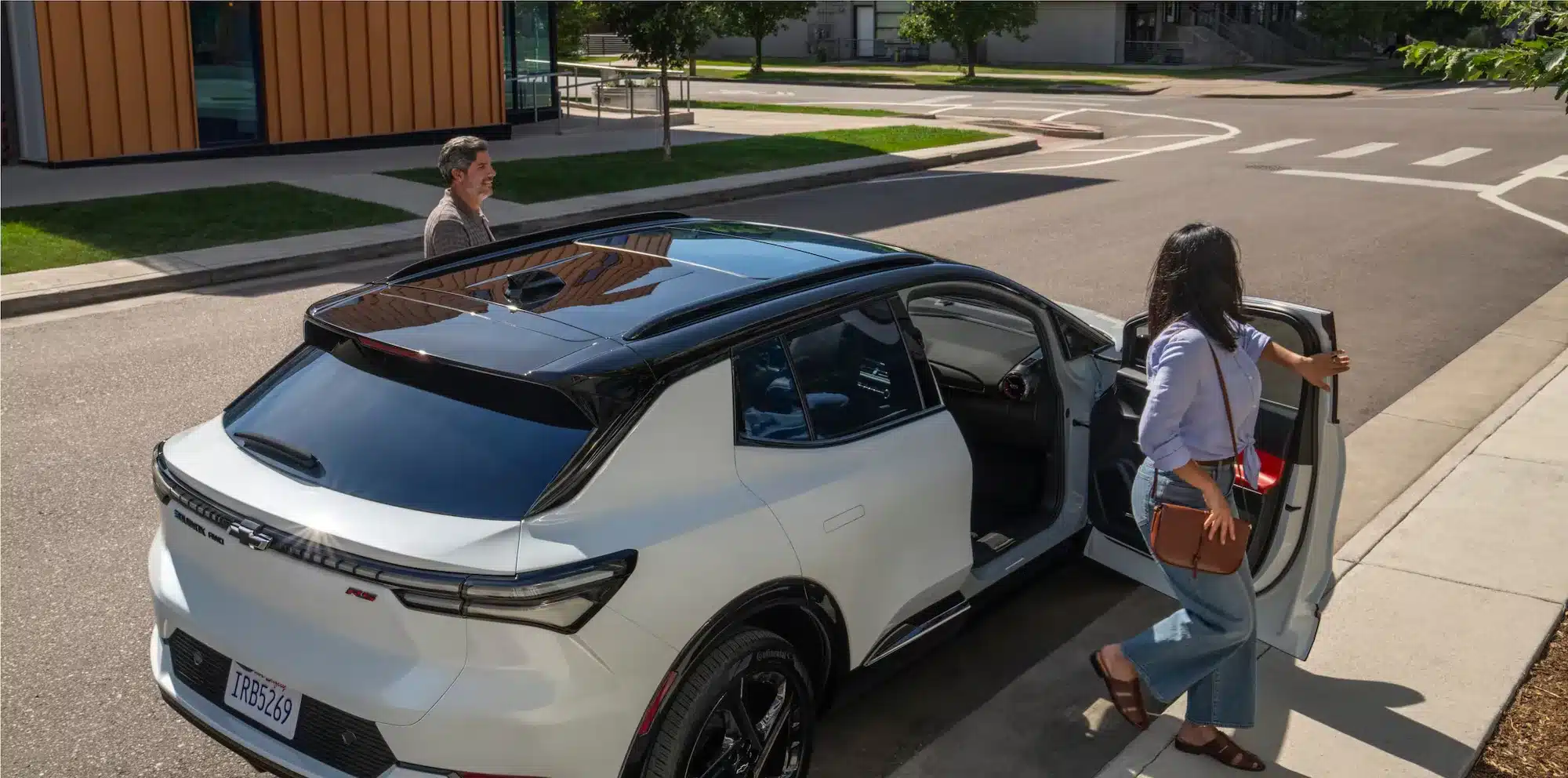In 2024, the federal EV tax credit goes to individuals who purchase a new, qualified electric vehicle, provided their modified adjusted gross income (MAGI) doesn't exceed $150,000 for single filers, $225,000 for heads of households, or $300,000 for joint filers. Remember, the vehicle must be for personal use and meet specific battery capacity and manufacturing requirements.
Welcome to Electric Savings
At Jake Sweeney Chevrolet In Cincinnati, Ohio

Federal Tax Credit For Electric Vehicles
Exciting times are ahead as we move towards a cleaner energy future! In 2024, there will be increased federal tax credits for electric vehicles (EVs), allowing you to impact the environment while saving money positively. Are you ready to switch to an electric commute? Let's delve into the details!
Your Guide To Going Green And Saving Big
Adopting an eco-friendly lifestyle has never been more rewarding! You can keep more green in your pocket with the latest federal EV tax credits. These incentives are designed to make electric vehicles accessible and affordable, ensuring you can join the sustainability movement without breaking the bank. Get ready to charge up your knowledge on how these credits can lead to huge savings and a smaller carbon footprint!
Understanding Your Eligibility
Assessing If You Qualify For Ev Tax Credits
Discovering your eligibility for EV tax credits is simpler than you might think! To qualify, the vehicle you have in mind should be an electric or plug-in hybrid with a battery capacity of 5 kWh or more, and it must be a new purchase. Additionally, it should primarily be used within the United States. To dive into the specifics of the credits, ensure that the manufacturer has sold fewer than 200,000 qualifying vehicles. It's important to note that these incentives are tailored, and by 2024, they will be VIN-specific. Stay updated with the latest information to ensure you're on track for eco-friendly savings!
Income Limits And Other Requirements For Savings
Your income plays a pivotal role in qualifying for EV tax credits. The thresholds are straightforward: $300,000 for married couples filing jointly, $225,000 for heads of households, and $150,000 for other filers. But don't jump to conclusions based on your salary alone. You'll need to consider your Modified Adjusted Gross Income; peek at Line 11 on your 1040 form, as this figure truly counts.
A pro tip: contributing to a 401(k) or similar plans could bring your Modified Adjusted Gross Income below the set income limits, even if your salary suggests otherwise. As for what else is required, you must buy the vehicle for personal use and within the U.S. borders. These requirements are steadfast, so cross-checking these can mean the difference between snagging those savings or missing out.
Making The Right EV Choice
Navigating The List Of Qualified Vehicles
Diving into the exciting world of EV ownership involves staying updated on which cars qualify for the valuable tax credit. The eligible vehicle list changes annually, reflecting the dynamic progress in this industry. Manufacturers are swiftly adapting to the new regulations to ensure their vehicles remain eligible, so stay informed and watch out for the latest updates!
How Price Caps Influence Your Tax Credit Potential
Exploring EV tax credits involves a crucial stop at the price cap station to ensure accessibility to a wide range of consumers. Adhering to price caps allows new EVs to qualify for tax relief, making these benefits more accessible. Staying informed about price caps is essential while shopping for an EV, as they are crucial in determining the amount of credit you can enjoy.
Important Requirements
Final Assembly Requirement
The vehicle must be finally assembled within the confines of North America.
The automobile's window label provides details such as the vehicle's weight, battery capacity, final assembly location (indicated as the "final assembly point"), and Vehicle Identification Number (VIN).
To verify whether a particular automobile meets the final assembly location criteria, visit the Department of Energy's section on Electric Vehicles with Final Assembly in North America and use the VIN Decoder feature under the "Specific Assembly Location Based on VIN" section.
Critical Minerals And Battery Component Requirements
Starting April 18, 2023, vehicles placed into service (received by the customer) will see their credit value determined by compliance with essential minerals procurement and sourcing of battery components. If a vehicle satisfies both procurement criteria, it could qualify for a maximum credit of $7,500. A vehicle that meets only one of the criteria may qualify for a reduced credit of $3,750. Credit is only granted to vehicles that meet the sourcing requirements. Sometimes, it will be necessary to consult with your dealership to verify the specific vehicle's eligibility and the potential amount of credit.
MSRP Requirement
The recommended retail price set by the vehicle's manufacturer must not surpass:
- $80,000 for vehicles classified as vans, SUVs, and pickups
- $55,000 for all other types of vehicles
The MSRP represents the initial price proposed by the vehicle maker and the suggested retail price for any added accessories or optional features installed on the vehicle before it's handed over to the dealership. This figure does not encompass delivery charges, the price for optional extras installed by the dealer, or any taxes and fees. Furthermore, incentives provided by the manufacturer or dealer and the value of trade-ins do not influence the MSRP.
The Claiming Process Simplified
From Purchase To Tax Time: A Step-by-Step Guide
The journey from purchasing your new electric ride to claiming your tax credit is a road trip with several milestones. Here's your roadmap:
1. Purchase an Eligible Vehicle: Make sure the EV you're interested in is on the qualified list and adhere to the price cap restrictions.
2. Obtain Documentation: Keep all pertinent paperwork, including sales receipts and the Manufacturer's Certification Statement, confirming your vehicle's credit eligibility.
3. Confirm with the Dealer: Ensure the dealer is registered with the IRS. They will usually handle the immediacy of the credit, showing it as a discount or cash back at the time of sale. Get copies of the bill of sale and IRS confirmation for your records.
4. File Your Taxes: Remember to file the credit paperwork with your tax return. Keep precise records; incorrect filings can lead to repayments if your circumstances change mid-year.
5. Monitor Adjustments: Be vigilant about any subsequent IRS guidance that might affect your situation, especially if you push the income limit thresholds.
Remember, EV ownership requires both environmental consciousness and financial savvy. Navigate it well, and you'll lead the charge toward a cleaner future and fiscal benefits!
Leasing vs. Owning: What Affects Your Credit?
Leasing or owning an EV affects your tax credit eligibility quite differently. When you lease, the tax credit transfers to the leasing company, as they're the official owners of the vehicle. They often apply the credit value to reduce lease payments, translating to your upfront savings.
However, when you purchase an EV, the tax credit is all yours, assuming you're eligible. With ownership, you'll claim the credit while filing your taxes, not at the vehicle's point of purchase.
Remember, leasing can come with mileage caps, and you can own the vehicle at the end of the term. Owning means the car is yours once the payments are made. Each option has pros and cons, so weigh them carefully to see which route best drives your finances and lifestyle forward.
Extra Perks Of Ev Ownership
State Incentives That Sweeten The Deal
Beyond the federal landscape, exploring your local incentives can be like unlocking a treasure chest of discounts and perks. For example, in some states, the driver might cruise into carpool lanes with a unique access sticker, while in others, they can stack up to $2,000 in state rebates on top of federal credits.
Remember that some states prohibit "double-dipping" into federal and state incentives, so read the fine print before cashing in on that green. It's crucial to check your state's Department of Motor Vehicles or alternative energy programs for the complete list of incentives. EV rebates, tax credits, grants for home charger installations, and utility rate reductions are all available.
Circle back often, as these incentives can rev up or wind down depending on legislation changes. You could quickly be on the highway to high savings with the right mix of federal and state incentives!
The Future Of EVs: More Than Just Tax Savings
Eyes on the horizon electric vehicles offer a shimmering future beyond tax savings. With more manufacturers shifting to electrification, a broader range of EV models, from sedans to trucks, are set to energize the market, offering something for every driver.
The growth of public charging stations is also accelerating, making road trips and longer commutes more feasible. These advancements, coupled with innovations in battery technology, promise extended range and reduced charging times, which are keys to mainstream adoption.
Investing in an EV is not just about financial incentives; it's a stake in a cleaner, sustainable future where transportation harmonizes with the environment. So, when you consider joining the electric evolution, consider the long-term impact on your savings and the planet!
